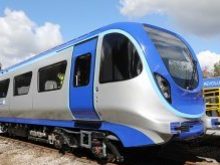VLR Revolution - what you need to know
Posted on 30th January 2023 at 16:45
Lighter-weight rail vehicles, running on a simplified and lighter-weight trackform. Far from new concepts, for decades the rail sector has worked on ways to streamline the delivery of rail systems, making construction and operations simpler, quicker and more affordable.There have been some successes along the away, as well as a number of notable failures, but a convergence of technologies related to the delivery of future transport systems has crystalised in recent years under the new banner of ‘Very Light Rail’, or VLR.But what exactly is VLR? Who is working on the technology? And where are the trial projects? As THE experts in LRT, Mainspring offers you a whistle-stop tour of the most recent developments…
Revolution VLR:
Two new UK Government-funded pathfinder projects have drawn widespread attention: ‘Revolution VLR’ and Coventry City Council’s ‘Urban VLR’ R&D scheme. The origins of the former lay in the ‘Radical Train’ competition launched in 2014 by the UK’s Rail Safety and Standards Board (RSSB) and the Department for Transport.
An open brief gave applicants the opportunity to come forward with concepts to reduce the costs and timescales in delivering rail projects. One entry attracted a consortium of leading lights from the automotive and rail sectors and the lightweight, self-propelled Revolution VLR (RVLR) railcar was born. A prototype was developed by a consortium which included Warwick Manufacturing Group (WMG) at the University of Warwick, Eversholt Rail, the RSSB and Transport Design International (TDI).
Using cutting-edge technologies and materials from rail, automotive and aerospace, it is challenging the accepted ‘norms’ to enable lower-cost operation of non-electrified suburban and rural routes, including the revitalisation of unprofitable branch lines and allowing the re-opening previously-closed ‘Beeching’ routes.

The Revolution VLR demonstrator at the Ironbridge test track, showing the modular vehicle concept and a simple 'pop-up' station. Eversholt Rail/TDI
The resulting demonstrator has an unladen weight of 24.8t – a 40% reduction over the Class 153 DMUs used widely across the UK’s rail network. It uses a steel chassis, an aluminium roof, recycled composite panels and new interior materials. Repurposing existing components where possible also removes the temptation to ‘reinvent the wheel’: for example, the bogies are derived from an existing freight wagon product and use hollow-axle wheelsets and 720mm wheels (rather than the more common heavy rail 850mm type). Carbon propshafts and electric braking, eliminating the need for pneumatic and hydraulic systems, all add to the savings and reduce complexity.
Traction power is via two turbocharged Euro-6 Cummins diesel engines, paired with lithium-titanate battery packs. This combination offers zero-emission operation and near-silent running up to 32km/h (20mph). The prototype’s top speed is 105km/h (65mph) and powertrains can be adapted to specific operational parameters and exchanged in under an hour.
Remember: This is only a small taste of what Mainspring can offer you terms of knowledge and data.
We are THE experts in light rail across the globe. Whether you need information regarding entering the marketplace, positioning yourself within the market or exploring the latest opportunities across the LRT world, we can help. Contact us today by clicking here!

This content will only be shown when viewing the full post. Click on this text to edit it.
Tagged as: Revolution, VLR, Coventry, Very Light Rail
Share this post:

